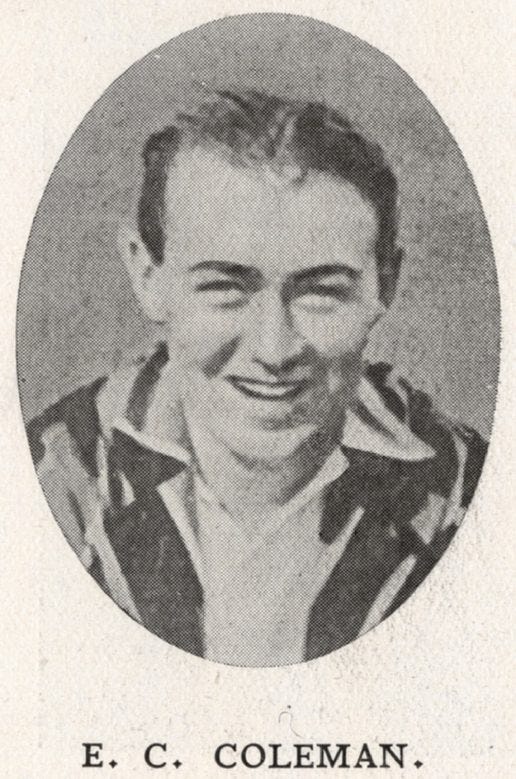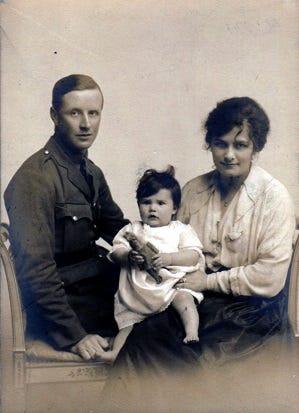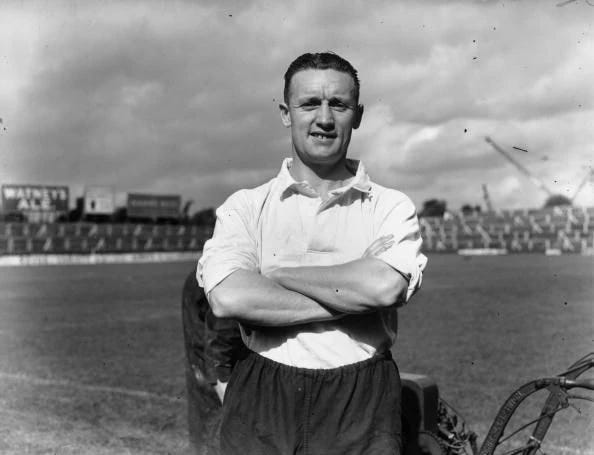Essex County Cricket Club in the two World Wars
Researched and written by David Pracy for the Peter Edwards Museum and Library, 2010
At Leyton on 24th August 1914, three weeks after the outbreak of World War I, the brilliant young all-rounder Geoffrey Davies scored his maiden first-class century. He took just 81 minutes and ‘hit in brilliant style’ with Colin McIver, the pair adding 108 in 50 minutes. That evening, the Essex committee met and proposed that “Members of the Staff volunteering in the war should have their places kept open for them”. By the end of September “all available members of the team (amateur and professional) and of the ground staff had already joined the army”. A year later, one month short of his 23rd birthday, Davies was Essex’s first first-class cricketer to be killed in action.
On 21st April 1915 the committee wrote to King George V, whose secretary replied: “I have laid before the King your letter of yesterday, enclosing a list of Essex County Cricketers serving in HM Forces during the War, which the King has read with much interest and satisfaction”. This was not just a matter of doddery old buffers blithely sending young men to their deaths: three of the committee—McIver, Charles Round, and the Essex captain Johnny Douglas—joined up and were commissioned in the Army. No one eligible for military service was employed to work on the ground, which was nevertheless constantly in use for a variety of patriotic causes. In 1917 the committee sent out a list of 64 “members of the Committee, of the First and Second Elevens and the Ground Staff who are serving their Country in various capacities in connection with the war ... The long list of names should inspire those who cannot engage in active service to continue their support of the Old Game when so many active supporters of it are risking their lives in defence of their King and Country”.
In 1919 all county cricketers who had served in the war were invited to the club’s annual dinner as guests, and the committee placed in the pavilion “a Roll of Honour for those of the First and Second Elevens who had fallen”.
Lieutenant Edward Charles Coleman (1891-1917) attended Dulwich College and Pembroke College, Cambridge. He twice kept wicket for the First XI in 1912, and also played for the Second XI in 1910 and 1914. Before the war he held a commission in the Reserve of Officers, Royal Field Artillery, and volunteered for active service at the outbreak. He was posted to the 4th East Anglian Brigade and promoted Lieutenant in January 1915. On 2nd April 1917 he was killed in the trenches at Salonika, where British forces were supporting their Greek and Serbian allies.
Captain Geoffrey Boisselier Davies (1892-1915) attended Rossall School and Oxford. A fine all-round athlete, he was a hard-hitting bat with strokes on both sides of the wicket, a rightarm slow-medium bowler and an excellent slip field. For Essex he played 32 First XI matches, scoring 757 runs at an average of 17.60, taking 68 wickets at 26, and 27 catches. In his final game he made 118 out of 155 and took 4 for 18 as Essex beat Somerset by ten wickets. He was commissioned in the Essex Regiment and rapidly rose to the rank of captain but was killed at Hulluch in France on 26th September 1915, a month short of his 23rd birthday. Wisden considered “there can be little doubt that, but for the war, he would have developed into an England player”.
Rifleman Paul James Hilleard (1894-1915) was a company clerk, who played four Second XI games in 1914. Against Surrey at Leyton his 85 not out was “a capital display”. Serving in the London Regiment (the Rangers), he was killed on 24th April 1915 in the Second Battle of Ypres, when the Germans released poison gas into the Allied lines. The 1917 List says that he was “reported killed in action, now reported prisoner in Germany”, but the original report was correct.
Second Lieutenant Henry David Keigwin (1881-1916) attended St Paul’s School and Peterhouse, Cambridge. He was music director at the famous Glenalmond College in Scotland. In 1906 and 1907 he played four games for the Essex First XI with little success, although he did score 77 for the Gentlemen of England against Surrey. He came voluntarily from Rhodesia in January 1916 to join up through Cambridge University with the Lancashire Fusiliers. He died on 20th September 1916 near Thiepval, during the latter stages of the Battle of the Somme.
Private Harold Mead (1895-1921) was the son of the great Essex slow bowler Walter and played alongside his father twice in May 1913, although his performances never suggested that his achievements would rival Walter’s. He was severely wounded in 1915 while serving with the Essex Regiment, and never fully recovered.
Captain Edward Roy Pallett (1895-1918) was the son of a doctor and attended Repton School. He played three Second XI matches in August 1914. His best performance was against Kent, when he scored 79 and added 161 for the 9th wicket with Harry Hills, who was himself wounded in the war. In October 1914 Pallett was commissioned as a temporary Second Lieutenant, and he later became a Captain in the 7th Battalion of the Royal Fusiliers. He was killed at Aveluy Wood on 6th April 1918 during the German Spring Offensive, when overwhelming numbers released from the Russian front drove the Allied Armies back across the former Somme battlefields.
Second Lieutenant Ralf Hubert Robinson (1885-1917) was a stockbroker’s clerk. A fine amateur wicket-keeper, he kept wicket for Essex four times in 1912, catching nine and stumping four. He won the Military Medal and was commissioned as a Second Lieutenant in the Rifle Brigade, but was killed near Ypres on 23rd August 1917. His widow Daisy asked whether she “could have his County Cap for the sake of their son”, who was born after his father’s death, and the committee forwarded it with “the greatest pleasure”. Sadly the boy, Ralf Hubert Reginald Robinson, was also a casualty of war, killed in 1942 while serving as a Lieutenant with the Eighth Army in Libya.
Lieutenant Frank Street (1870-1916) was educated at Westminster and Oxford. While a master at Forest School, he played nine matches for Essex in 1898 and 1899, scoring 246 runs at an average of 22. Though over age, he volunteered to serve in the Royal Fusiliers and was killed by a sniper’s bullet on 7th July 1916, in the first week of the Battle of the Somme.
Second Lieutenant Cecil Victor Thompson (1897-1917) of the East Lancashire Regiment was one of the best all-round sportsmen of his time at Forest School. He was one of their main bowlers and made the highest individual score of 1914, 161 not out. In August 1914, he played four Second XI games as an all-rounder. Although none of his performances was outstanding, he was barely 17 and a cricketer of great promise. He was wounded in France and mentioned in dispatches, but killed in action near Basra in Mesopotamia (Iraq) on 6th February 1917.
Major Douglas Tosetti (1877-1918) was a champagne merchant who played five games for the Second XI in 1900-3, with little success. A stalwart of the 8th Royal Berkshires, he was wounded at Loos but continued to lead his men and so earned the Military Cross. He also fought on the Somme and at Passchendaele, and rose to be second-in-command of the battalion. He was killed on 21st March 1918, the first day of the German Spring Offensive.
Lieutenant James Valiant (1884-1917) was a ground bowler who played one first-class match in 1912. The son of a Liverpool butcher, he was not born into the officer class but rose to the rank of Lieutenant in the Royal Welsh Fusiliers. He was killed at Gaza in Palestine on 28th October 1917.
Captain Arthur James Waugh (1887-1916) appeared on the 1917 List although he never played for Essex, perhaps because of his medical studies. Against Essex Club & Ground at Leyton, he scored 71 not out and took 8 for 52 for Forest School in 1905, and took 9 for 6 for Old Foresters in 1911. He was killed on the Somme on 17th August 1916, while serving as a captain in the Royal Army Medical Corps, attached to the 1st Battalion of the North Staffordshire Regiment.
In 1914, Essex arranged Second XI matches for the first time since 1910. No fewer than five of the team that played in the last game of the season, against Surrey at The Oval on 26th and 27th August, were among those who died—Coleman, Hilleard, Mead, Pallett and Thompson. Three Essex cricketers who survived the war were awarded the Military Cross—Lieutenant Joseph Gilbert Dixon, Lt-Col Guy Janion Edwards and Captain Frederick Luther Fane. Lieutenant Richard Prescott Keigwin of the Royal Naval Voluntary Reserve was made a Chevalier de l’Ordre de Léopold, the highest military award in Belgium.
Captain Vivian John Woodward of the 17th Battalion of the Middlesex Regiment (the Footballers’ Battalion), who played two games for Essex Second XI in 1902 and 1903, was better known as a brilliant centre-forward for England, Spurs and Chelsea, an amateur who starred in professional football.
In 1939 the Essex committee, like the country as a whole, took an altogether less gung-ho attitude to the war. They regarded it rather as a job to be done, and most of the cricketers joined up straight away. The Secretary, Lt-Col Brian Kenneth Castor, was caught up in the fall of Singapore and became a Japanese prisoner of war. His fellow-POWs said “he was a wonderful chap”. Captain, later Lt-Col, John William Arthur Stephenson was already an army officer, and commanded a battalion of the Middlesex Regiment. In 1944 he was awarded the DSO for service in Tunisia.
Several of the professionals became officers, including Pilot Officer Reginald Minshall Taylor, who for his service as an observer with Bomber Command at Dunkirk became the first professional cricketer to win the DFC, and Captain Thomas Peter Bromley Smith of the Essex Regiment, who in 1943 was appointed staff-captain of Combined Operations and Troop Movements at Alexandria in Egypt. Peter’s cousin Raymond Smith, who as a farmer was in a reserved occupation, played in many matches arranged for war charities, often as captain.
All of the professionals did their bit for the war effort. Not only did they serve in the forces; they also helped raise morale at home. They played in the fund-raising matches while on leave, and helped enthusiastically with various popular coaching schemes organised by the club. All of this undoubtedly contributed to their obtaining improved pay and conditions after the war. Three Essex cricketers from the popular and successful side of the 1930s died in World War II, none overseas. By a strange coincidence, two were killed in flying accidents while training. Lawrence Charles Eastman (1897-1941) was educated at Leyton Technical Institute. In World War I he was awarded the Distinguished Service Medal and the Military Medal. He made his Essex debut as an amateur in 1920 and was assistant secretary from 1922 until 1926, when he turned professional. A hard-hitting batsman who often opened the innings, he was also an effective leg-spinner, regarded by Cecil Parkin as ‘a good all-rounder and a very happy fellow’. In 1939, Eastman was injured during his benefit game against Middlesex at Southend and helped Ray Smith add 15 for the last wicket, but was then out and Essex lost by five runs. The benefit raised over £1000 but sadly he did not have long to enjoy it. He played in wartime. charity matches for the London Counties team and captained them on their first appearance at Lord’s. Ironically, he survived the Western Front but was on duty as an ARP warden when a bomb exploded near him and he died after an operation.
Kenneth Farnes (1911-1941) was an Essex giant in every sense of the phrase. Six foot five inches tall, he was a genuinely fast bowler who in the 1930s took 362 wickets for the county at an average of 19, and a career total of 685 at 22. He played in 15 Test matches, and seven times for the Gentlemen v the Players. He attended Royal Liberty School Romford, and Pembroke College Cambridge. He graduated in history and geography which he taught at Worksop College in Nottinghamshire, where he was a housemaster. The boys remembered him as a tall, handsome, modest man with “a love of life and an enjoyment of fun”. His headmaster gave him leave of absence for three overseas trips, and his beautifully written autobiography Tours and Tests owed as much to his desire to travel as to his love for cricket. In 1938 Farnes was the leading bowler in the country, and Bill Edrich said that at Lord’s for the Gentlemen he “bowled faster that evening than any bowler I have ever met”. Farnes joined the RAF and volunteered as a night flier, but crash-landed on his first unsupervised flight and was killed instantly. The inscription on his grave carried echoes of an earlier age: “He died as he lived, playing the game”.
Claude Thesiger Ashton (1901-1942) was perhaps the most talented of four cricketing brothers. He was a hard-hitting middle-order batsman, useful medium-pace bowler and brilliant fielder, but his work as a chartered accountant meant that “Essex could have done with the help of Claude Ashton ... much more often”. In 1934, though, he starred in the amazing Brentwood festival week, when in five days 2,362 runs were scored as Essex first lost to Kent by an innings and 192 runs and then beat Surrey by exactly the same margin. Against Surrey, Ashton and Jack O’Connor hit career-bests and in only 140 minutes shared in a fifth-wicket partnership of 287 that was an Essex record until 1991. Ashton was an Acting Squadron Leader in the RAF when on 31st October 1942 he was killed while on a training flight over Bangor in Wales. He was the navigator when a Beaufighter piloted by another Winchester and Cambridge cricketer, Roger Winlaw, collided with a Wellington. The annual report said “Essex cricket will be the poorer by the death in a flying accident of that brilliant sportsman and gallant officer C.T. Ashton”. In the MCC museum at Lord’s, the plinth on which the Ashes stand was donated in memory of Ashton and Winlaw.
This article first appeared in The Cricket Statistician for Winter 2010. To join the Association of Cricket Statisticians and Historians, and subscribe to the journal, please visit our website:








